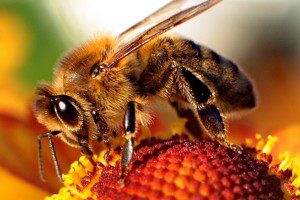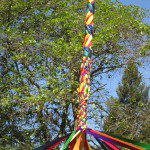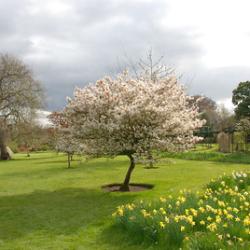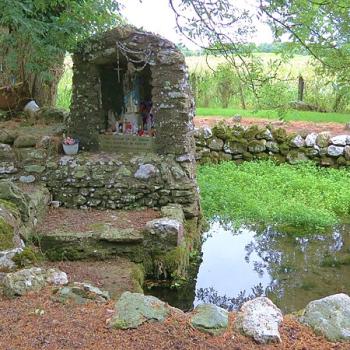
I love Beltaine. I love flowers. I love early summer. I love sex. I love fertility and fruitfulness. What’s not to love?
Weeeeeell, if you’re a queer person in Pagan community, Beltaine can be fraught with conflict and ambivalence. Simplistic understandings of Maypoles, Bael Fires, and related ceremonies leave us with heterosexist, patriarchal ideas of what the holiday is about.
For example, “Beltaine is about men and women fucking,” a Pagan leader once said to me, showing an astonishing lack of imagination. The Maypole is about penis and vagina coming together to create children. Gender polarity—expressed in the bodies of cis-gender men and women working magic together, boy-girl-boy-girl—is the root of fruitfulness. Beltaine is the time when “classic” Wiccan ideas about polarity and complementarity can squeeze out other ideas.
Now penis-and-vagina meetings can certainly be queer. Even complementarity—when it’s not imposed or expected—can be fruitful and fertile in many ways.
In any event, I am a lesbian, and I know what it is to be excluded from the religious expression of my community. I know what it is when ritualists’ ideas about metaphor leave me out. And that’s ridiculous, frankly. Like many others, I left a religious community that routinely excluded me; I shouldn’t have to deal with that exclusion in UU, Pagan, and UU-Pagan environments. Particularly not on a holiday as rich and glorious as Beltaine.
Put simply, Beltaine is NOT just “about men and women fucking.” Not even as a metaphor for Earth’s fruitfulness. Not even.
As Unitarian Universalists, we espouse individual worth and dignity, the need for justice and compassion, and the interconnectedness of life. So if our Beltaine ceremonies are based only on a heterosexual, complementarist idea of fertility, we are falling down on the job. We are excluding queers and impoverishing everyone. We are allowing a lack of imagination to get in the way of good ceremony.
So what is a Beltaine ritualist to do? How is one to get to the heart of the holiday? How is one to figure out what that heart is, what is the rhythm of its beating, the flowing of its blood? Do we simply say, “Fertility is whatever you like”? Do we simply say that non-queer relationships are just as fruitful as other relationships and so replace the boy-girl-boy-girl arrangement of classic Beltaine ceremony with other relationship models?
I suggest that we go further, and go into our roots. Way into our roots. Deep, deep down into the roots of ceremony. Ceremony is a way of telling stories, of reminding ourselves and our children—the children of our communities—what is important and bears protecting. And so I offer one example of a way into Beltaine, an inclusive, multigenerational way that does more than replace boy-girl-boy-girl with boy-girl-boy-boy.
The Gift of the Bees
One ritual revisioning Beltaine fertility happened at Four Quarters Interfaith Sanctuary’s Beltaine Main Ceremony, May 2006. This ceremony used bees and flowers, rather than human beings of any gender, as the model for fertility and love. Bees and flowers are sexy in the extreme—right down to the fantastic, shimmy-shimmy-butt-waggle dance that bees do to share the locations of yummy nectar. And that’s not even to mention the glory that is flowers’ powers of attraction.
(I should say before I continue that the second half of this ceremony happened in a raging downpour. A true cloudburst. The rain didn’t spoil anyone’s fun, and the ritual continued. Still, the weather bears mentioning.)
The ceremony delighted in the beauty and fun of Beltaine. The “bee people” wore gold deelyboppers on their heads. (Deelyboppers, for those who are not children of the eighties, are those springs on headbands with balls on the top—alien antennae, more or less.) The Queen Bee was covered in black and gold, glittery and curvaceous. The “flower people” were dressed all in bright colors, their faces and bodies painted in pink and purple and green. The children carried flowers, the altar was covered in flowers, and flower-scented water purified participants as they came into the Circle.
The ceremony reminded participants of everything that bees make possible. We symbolized their powerful place in ecosystems around the world through the symbolic use of bee pollen (East), a beeswax candle (South), mead (West), and honey (North). In the repetition of “the gift of the bees!” we reminded ourselves and one another of our dependence on beneficial pollinators, particularly bees.
The ceremony underscored the fertility that bees and flowers engender, the unique place of honeybees on Earth, and our own bee-and-flower-like qualities. As “bees” “flew” to “flowers” over the course of the ceremony, we saw love across difference leading to fertility of all kinds. As the whole assembly danced with the Queen, we reminded ourselves and one another of the unique communication that bees share with one another. As participants shared honey-soaked bread with one another, we took in the fruits of bees’ labor—both the honey itself and the grain that grew to become the bread.
The Interconnected Web
This ceremony was not only an expression of Beltaine delight, it was a gentle admonition. It was a reminder that bees—these beautiful creators of fertility—are in danger, are dying, are being destroyed by pesticide. It was a reminder that just as we are given “the gift of the bees!” so are we called to make gifts of our lives. A reminder that people need to give to the bees as the bees give to us.
Furthermore, it was—as all truly great ceremonies are, in my opinion—fully multigenerational. There were chairs for those who needed them, whether elder or not. There were parts for those who could move around easily (bees) and parts for those who are more comfortable being in one place (flowers). There were roles for children—remember the splashes of that flower-scented water and those bright bouquets?
The whole thing was fun! Everyone got to dance, there were a bunch of drummers, and laughter was the order of the day.
Inclusion at its Best
Sometimes, as UU’s we can get the whole “inclusion” thing all wrong. We allow disruptive or damaging behavior to continue unchecked, all in the name of “individual worth and dignity.” We claim our own theology or understanding of Unitarian Universalism is what UUism is, rather than being our own take, angle, experience, or understanding.
Rituals like the one I’ve described, though, are what can happen when we really think through inclusion. This inclusion doesn’t damage the larger community, but rather builds it up. This inclusion comes about through skillful use of metaphor, metaphor that allows us to embrace the whole human and Earthly family. Using metaphor skillfully is what ritual is all about; it’s storytelling through image, activity, and sign.
So as we enter into the Tide of Beltaine, let us think on the profusion of Earthly delights the holiday has to offer. How delight, joy, love, attraction, flowers, animals, insects, fertility, fruitfulness…how all these and more can come together in the holiday that is also the celebration of the Pole and the Wreath. How people of all (not merely “both”) genders can embody the glories of the season. And how therefore, we—all and each—are called into the wonders of the gateway to summer, the beauty that is Beltaine.
Photos courtesy of Shutterstock

















